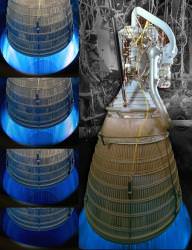Here on Earth, we’ve gotten used to the concept of a car’s accelerator pedal. Put it down a little, and the car accelerates slowly. Put the “pedal to the metal” and you’ll go faster. Imagine trying to park your car when you only have two choices: off and full speed. Developing a similar concept for a rocket is very difficult. Most rockets are designed to go at full blast, or nothing at all.
A variable acceleration rocket would tremendously useful for landing on the Moon. Instead of firing the landing rockets in short bursts, astronauts could throttle down for a nice smooth landing. But building an engine like this is harder than it sounds.
NASA researchers think they’ve got a prototype engine that should give the variable rate of acceleration astronauts are looking for. The newly developed Common Extensible Cryogenic Engine (CECE) is a variant on the RL10 engine that boosted the Surveyor robot landers to the Moon back in 1966-68. The RL10 is designed to only go full throttle, so adding the variable thrust was difficult.
The main problem is that changing the throttle affects how the whole engine functions. At low power, liquid hydrogen can slow and vapourize in the coolant lines. This might cause the engine to stall. During one test, the experimenters discovered that the engine “chugged”, vibrating 100 times a second. It turned out oxygen vapours were forming on the injector plate, inhibiting normal flow, causing the vibrations.
It’s not ready for space yet, but CECE might eventually become part of the design of a future lunar lander. The astronauts returning to the Moon will be very appreciative.
Original Source:Science@NASA


I Love Earth!!!!!!!!!!!!!!